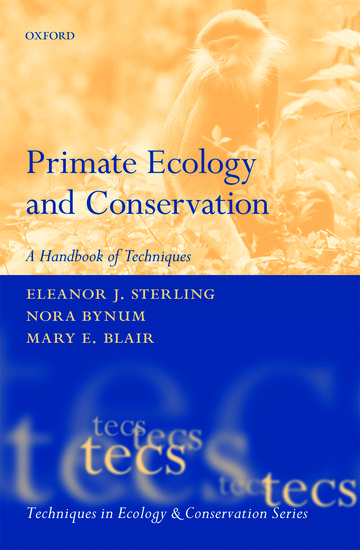By Mary Blair
Slow lorises are enigmatic nocturnal primates that are notoriously difficult to find in the wild. The five species of slow loris that have been evaluated by the International Union for the Conservation of Nature’s Red List of Threatened Species are classified as threatened or critically endangered with extinction. So, how did one end up recently on the set of Lady Gaga’s music video? Lorises don’t make good pets or video props, especially as they are the world’s only venomous primates. But, unfortunately, it is easier to see a loris as an exotic pet in a Youtube video or on Rihanna’s shoulder as a photo prop than it is to see them in the wild.
In my current research at the Center for Biodiversity and Conservation at the American Museum of Natural History, my team is surveying for Bengal (Nycticebus bengalensis) and pygmy slow lorises (N. pygmaeus) in Vietnam to determine their population status – how many lorises remain across different key sites in Vietnam, and how their current numbers compare to previous surveys. I have written before about the challenges my team has faced searching for these elusive creatures, but this time, I’d like to discuss the broader difficulties of searching for low-density, rare animals, and how knowledge gaps about these creatures can preclude the development of effective management plans for their conservation.

Intensive fieldwork on Vietnam’s primates only began in the mid-1990s, focusing on those species assessed to be the most in danger of extinction, especially gibbons (Nomascus spp.) and colobines such as snub-nosed monkeys (Rhinopithecus avunculus), doucs (Pygathrix spp.), and leaf monkeys (Trachypithecus spp.). Comparatively little research to date has focused on species assumed to be common such as the macaques (Macaca spp.) and the nocturnal lorises (Nycticebus spp.). These groups are presumed common because they seem to be able to persist in more diverse habitats including agroforest and regenerating forest, while gibbons, doucs, snub-nosed and leaf monkeys are found in established primary or secondary forests, which are rapidly depleting in Vietnam. As a result of this assumption, very few studies have focused on macaques or lorises in Vietnam and thus, there is very little if any information available to accurately assess their conservation status.
Now that researchers have started collecting data more intensively on slow lorises in Vietnam, we are finding that they are at such low densities that it is difficult to accurately calculate their density with statistical precision. However, as more and more researchers choose to focus on nocturnal, rare mammals like lorises across the globe (from owl monkeys to galagos to colugos), we can synthesize across our efforts to learn from each other, refine our methods, and generate more appropriate statistical models. In addition to continuing our surveys, we also working to raise awareness about threats to slow loris populations in Vietnam, and we are training local forest rangers and researchers to conduct ongoing population monitoring.

Ironically, in this case, there was the least information available about the animals assumed to be the most common. Without fundamental data on population status or distribution, it is difficult to either build effective conservation management plans for slow lorises or attract the federal and private funding necessary to implement such plans. And as such, major conservation actions in the region to date have focused on higher profile primate species, for which there is more information about conservation status. We are finally moving towards having enough scientific information to design a plan of action for improved conservation management of slow loris populations in Vietnam.
In Indonesia, at least 15,000 lorises are trafficked each year for the exotic pet trade. Numbers are not available for Vietnam or other countries in Mainland Southeast Asia, but our work so far suggests that pressure from the trade remains quite high. Our upcoming work in Vietnam, funded by the US National Science Foundation, will expand our research to include social science approaches to better inform policy makers about the underlying social and economic drivers of illicit trade in lorises. You can learn more about what other intrepid loris researchers are doing and how you can help to raise awareness and decrease demand for these endangered animals as exotic pets and photo props.
Dr. Mary Blair is the Assistant Director for Research and Strategic Planning at the Center for Biodiversity and Conservation at the American Museum of Natural History. Her research explores how knowledge of evolutionary processes can inform conservation planning. Her work in Vietnam is supported in part by the Disney Worldwide Conservation Fund and by a US National Science Foundation Science, Engineering, and Education for Sustainability Fellowship under Grant No. NSF-CHE-1313908. Mary has blogged about her work in Vietnam for the Museum’s Fieldwork Journal and for the New York Times, and is the author of Primate Ecology and Conservation. You can follow Mary on Twitter @marye_blair. Any opinions, findings, and conclusions or recommendations expressed in this material are those of the author and do not necessarily reflect the views of the U.S. National Science Foundation.
Subscribe to the OUPblog via email or RSS.
Subscribe to only earth and life sciences articles on the OUPblog via email or RSS.
Image credits: (1) A pygmy slow loris (Nycticebus pygmaeus) at the Endangered Primate Rescue Center in Cuc Phuong National Park, Vietnam. Photo by Dr. Mary Blair. Do not reproduce without permission. (2) A Bengal slow loris (Nycticebus bengalensis) at the Endangered Primate Rescue Center in Cuc Phuong National Park, Vietnam. Photo by Nolan Bett, used with permission.


Recent Comments
There are currently no comments.